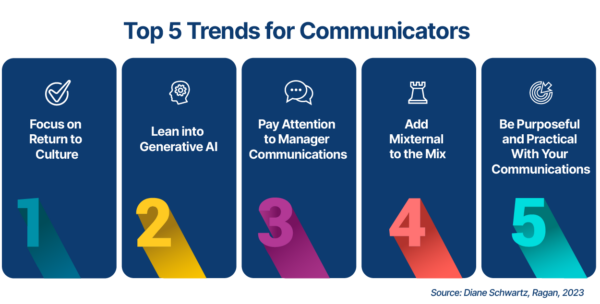Ragan’s #8 Story of ’23: Focusing on a ‘return to culture’ puts to rest to the return-to-office debate
Ragan ‘s CEO shares the top five trends facing communicators.

Gather a group of communicators and HR professionals in a room to talk about Return to Office strategies and the intensity of the conversation and energy in the room skyrockets. That was the case when attendees at Ragan’s Employee Experience & Wellness Conference in Denver were asked to make two lists: one of the benefits of working from home and another on the benefits of working in the office. Many expected lopsided results.
But when all was said and done, the group was surprised to see that the numbers of benefits in each column were almost equal. A dead heat.
So what’s all the fuss about going into an office, what with the free coffee, spontaneous conversations and the chance to attend a meeting fully dressed?
“All hell’s going to break loose tomorrow when the new return-to-office guidelines are announced,” one executive at a large PR firm told me. “Some people just never want to come into the office.”
At this conference, attended by communications and HR professionals alike, it was clear that communicators have a heavy weight to carry as they struggle to hold together work cultures that are being redesigned and redefined by the new rules of attendance.
This workplace shift, many years after the start of the pandemic, threatens culture, productivity and talent retention. As one conference attendee noted: “We need to focus on culture, not on why Sally is working from home on Tuesdays.”
From RTO to RTC
Framing return-to-office initiatives as a “return to culture” is an effective way of connecting with employees about this issue. Communicators should lead the way through the messiness and be okay with the idea of internal stakeholders figuring it out together. Getting your return-to-office campaign right requires a close partnership between Communications, HR and the C-suite that puts employee experience front and center. Even with the advancements in AI (see trends below), your human employees are the business drivers.
Ragan has distilled five key challenges communicators are facing — issues that also affect business leaders in Marketing, Sales, HR and Finance. The communicator, however, is in the most unique position of being the eyes and ears of the organization while also creating and owning the brand narrative.
As this year’s theme for Communications Week in November – “Leading the Way” — comes into full focus, communicators should take heed of these five major trends:

1. Focus on a return to culture. Employee behaviors, attitudes and engagement levels are defined only in part by whether they need to come into the office. Employees want to feel heard, respected, challenged, safe. Employers have every right to require that employees return to the office. Those companies finding success with their strategy will be the ones that treat employees with respect whether they’re in person, at home or in the field or factory, and are clear and consistent with their messaging and actions.
2. Lean into generative AI. While we’ve been using and benefiting from artificial intelligence (AI) for decades, new tools like ChatGPT, Bard and Midjourney have made the incredible opportunities—and risks—of automation accessible to communicators in unforeseen ways. On the positive side, we are already seeing the benefits of AI in terms of overall output, with 82% of respondents saying AI can help them be more productive. As communicators seek to trade in their order-taker status and be more strategic within their organization, they must learn how to put AI to the task to free their focus up for higher-level work.
But many aren’t ready to jump in headfirst just yet. Communicators polled in a recent Ragan/Conference Board Survey on AI, said misinformation and legal uncertainties topped the list of major concerns they have with the tools. This underscores why communicators need to be involved early and often in the conversations at their organizations around use of AI among their employees, creating guidelines for responsible use cases and prompt creation while keeping eyes wide open for misuse of the organization’s intellectual property.
3. Pay attention to manager communications. Employees don’t leave companies; they leave bad leaders. A manager ill-equipped to guide and inform their direct reports threatens the viability of that team and the organization. Communications leaders need to pay close attention to how information cascades in their organization and mend the areas where the flow has slowed from their high-level perspective at the top. Not every employee reads corporate emails or actively listens during town halls. Managers will increasingly rely on communications partners to help them keep their teams informed, engaged and connected.
4. Add mixternal to the mix. Another major change, borne of social media plus the increasing influence of the employee on an organization’s reputation, is the partnership between internal and external comms. More teams than ever are now led by a Chief Communications Officer or head of comms who oversees both internal and external communicators. A communicator operates at their peril if they don’t understand that what’s conveyed internally will be shared externally. And external campaigns impact the organization internally, too — what’s internal is external and vice versa. Mixternal communications recognize this truth, and communicators who craft mixternal strategies will see more airtight outcomes.
5. Be purposeful and practical with your communications. Employees, customers and other stakeholders are no longer just curious where a brand stands on social issues — they are taking note and action. In some cases they’ll leave your company, picket outside it or even stop buying from you. Communicators can no longer be on the receiving end of corporate dictates on social issues. They need to be part of the decision-making process. Actions around environmental, social and governance (ESG) will make or break some brands, especially mid to large-size organizations.
Climate communications is another growing area where communicators can mitigate risk and even help save lives. This year’s devastating fires in Maui and hurricane battering Palm Springs are a reminder that no place on earth is immune to a climate event – be it extreme heat, tornados, wildfires, hurricanes or powerful storms. Keeping employees safe, and confident that their workplace has safety measures in place, is now an expectation.
Communicators have made incredible strides over the past three years in navigating a pandemic, social justice issues and workplace culture changes. The next year will undoubtedly test their mettle. Embracing these five major trends will elevate their status as effective, creative and empathetic business leaders.





